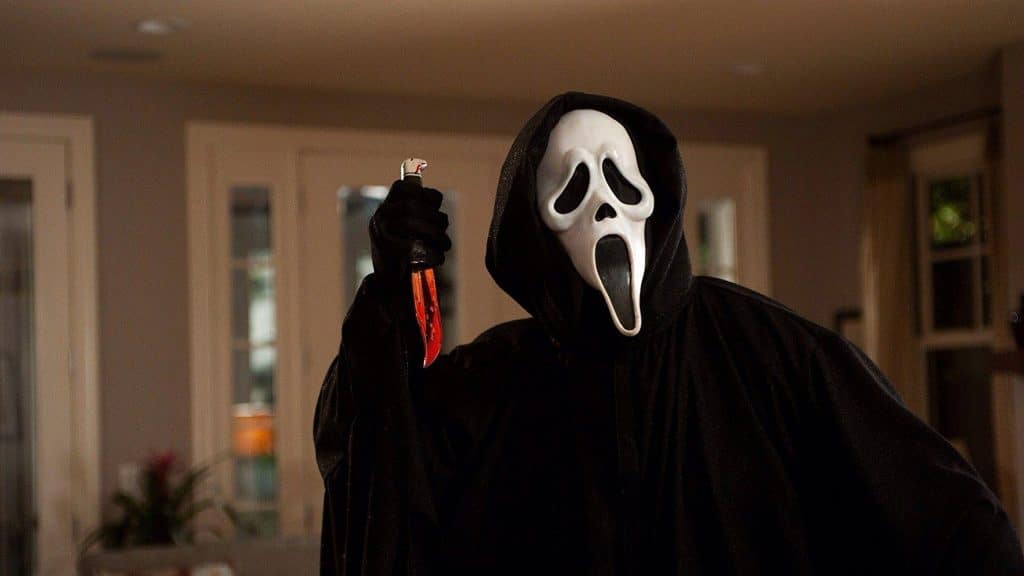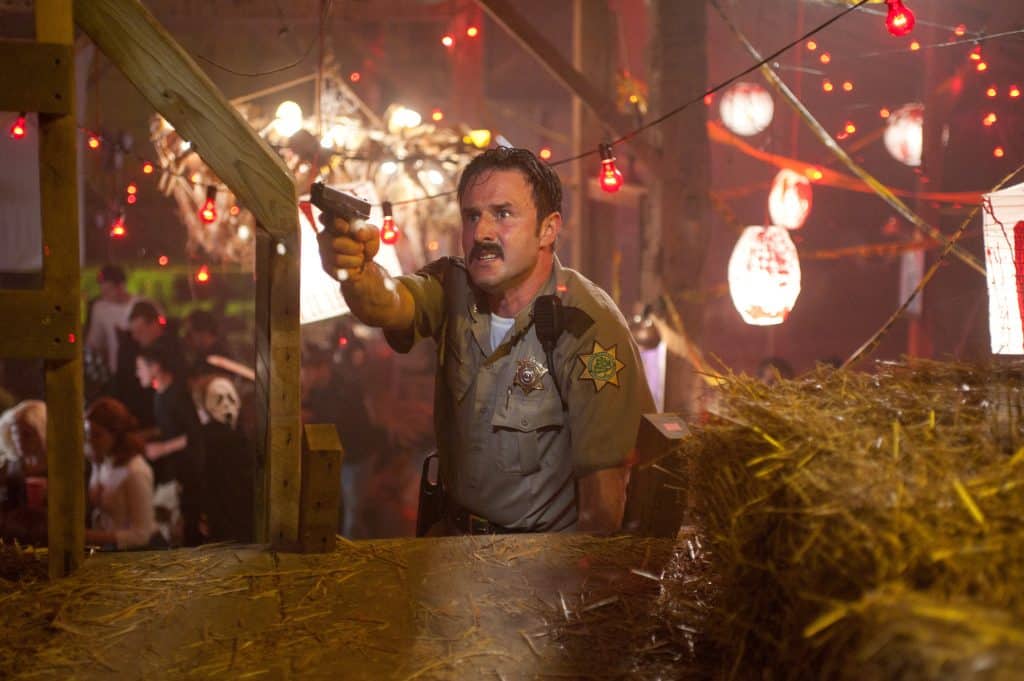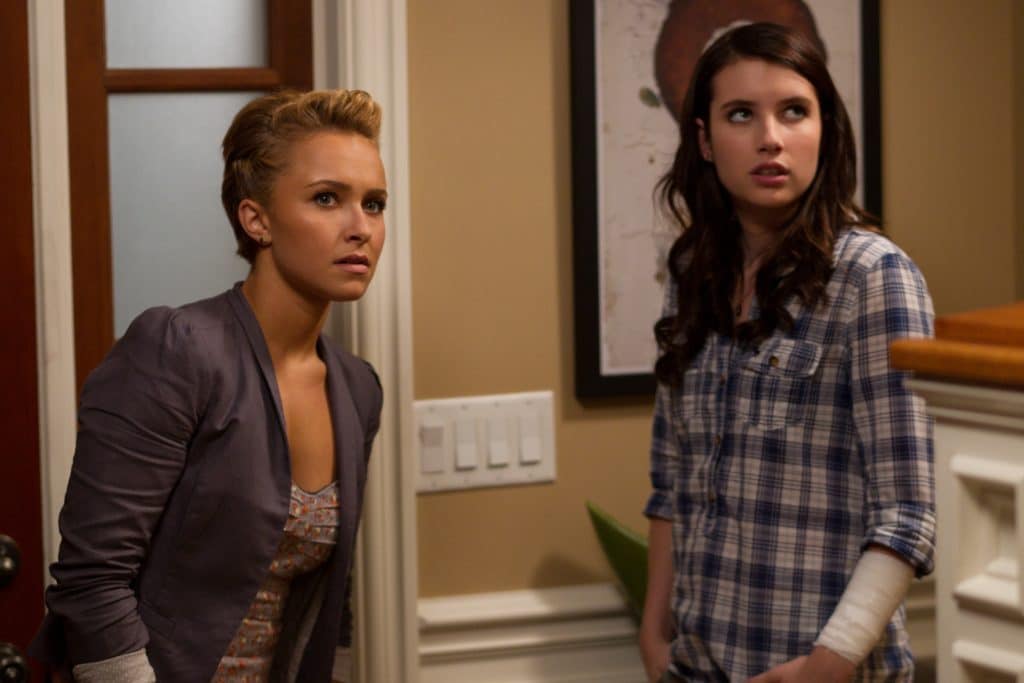From meta commentary to social commentary, Wes Craven’s final film is a bundle of cinephilic sarcasm that was ahead of its time.
For the horror genre, April 15, 2011, marked a handful of notable dates. On one hand, it was the 15th anniversary of when Scream started filming, starting with the 11-minute sequence in which an onscreen Drew Barrymore, thought by the masses to be the star, was eviscerated in the name of her killers’ pop culture fetish. The movie not only reintroduced the slasher film back into the mainstream, but it also brought back one of its maestros. Of course, that’d be Wes Craven.
His last horror movie, 1994’s Wes Craven’s New Nightmare, barely broke even. Then, his dismal 1995 Eddie Murphy comedy, Vampire in Brooklyn, downright flopped. Not only were his movies not hitting, but Craven himself wanted to break out of horror and the latent misogyny of many of its hits. As such, he initially declined to adapt Kevin Williamson‘s script that would later be known as Scream. Of course, Craven eventually gave in, and that day in April ’96 thrust him into his finest form. Jump ahead 15 years exactly and out came what would be his final film.
Again penned by Williamson, it would predict online influencer culture while weaving through the simultaneous decay and perseverance of the silver screen at the dawn of the 2010s. It’d be hilarious, biting, and inherently sad. It’d also be stranger than fiction, but that’s because it’d never break from reality. None of the first three Scream movies could have come out any time other than the turn of the millennium. By coming out at the turn of the decade, though, Scream 4 was years ahead of its time.
Perhaps that’s part of the reason it didn’t do too well. It came out before the legacy sequel kick took off in the mid-2010s. The marketing seemed all too scarce, and the trailers themselves were poorly edited and seemed to misunderstand the film’s sense of irony. As such, it grossed $97.2 million worldwide off a blatantly unnecessary $40 million budget. Reviews were mixed, the main complaints being that the movie was dated and the characters were too blasé. With everything going on onscreen, though, one has to wonder, How is that not what the movie is about?

It’s clear from the jump what it’s going for. Two girls (Lucy Hale and Shanae Grimes) get skewered in less than four minutes, and the choices are corny. Their phones are dated T-Mobile Sidekicks; they discuss 2007’s Saw IV. They’re ostensibly modern teenagers, but what are their names? Sherrie and Trudie of all things, but they turn out to be in the opening of Stab 6. When we find two women (Anna Paquin and Kristen Bell) watching it, their scene itself ends up being the opening of Stab 7. The two watching this are Woodsboro teens Jenny and Marnie (Aimee Teegarden and Britt Robertson). In their mirror of a mirrored-mirror reality, the events of the first three films are nothing but lore, and Ghostface voice-changer apps are the norm.
After both blurring and balancing parody and satire, we’re in it for real. Pieces of the original movie echo themselves and, in true Scream fashion, Ghostface offs the two girls. The main wrinkle, though, is how the movie introduces itself. As Ghostface delivers the final blow to Jenny, we see her final seconds in a point-of-view shot. But her final sight isn’t just a knife coming down on her or everything fading away: it’s the Scream 4 title card itself presented to us. We’re officially just as detached as the characters are.
While this cheekiness is most pronounced in the first 11 minutes, this sort of approach continues through the rest of the movie. We catch up with Sidney (Neve Campbell), who’s returning to her hometown to promote her new memoir. Her assistant, Rebecca (Alison Brie), is a doting little starfucker of sorts when she isn’t being as crass as Gale was in Scream. Meanwhile, Gale (Courteney Cox) herself is now married to Dewey (David Arquette), the former washed up and the latter the sheriff. If anything, Dewey’s more comfortable around Deputy Judy Hicks (Marley Shelton), whose admiration for her boss borders on comical and creepy.
Woodboro’s new generation, all the while, echoes who populated it 15 years prior. Sidney’s cousin, Jill (Emma Roberts), is the new good girl. Her fresh ex, Trevor (Nico Tortorella), is another Billy. There’s even a nerd named Robbie (Erik Knudsen) that’s even more pronounced than Randy was, except this time he livestreams everything via a headset for his website. More so, Jill’s next-door neighbor Olivia (Marielle Jaffe) is the sardonic “school’s hot chick” à la Tatum. Thankfully, most of the younger group also function as amalgams rather than direct reflections, such as Kirby (a stellar Hayden Panettiere) and her hapless suitor, Charlie (Rory Culkin).

This group couldn’t have existed 10 or 15 years prior. Whereas the Scream characters watched earnest horror fare in the form of the original Halloween, Jill and Kirby watch affectionate genre parody with Shaun of the Dead while the gang discusses the remake epidemic. While Randy bludgeoned everyone with his movie knowledge, Robbie bugs his friends by vlogging 24/7, essentially making his own “movies” of sorts. What makes them work isn’t just the chemistry, or the quick dialogue, or the individual performances of everyone (sans Tortorella, admittedly). It’s that while Craven and Williamson are fully aware of and focus on everyone’s roles in the series canon, they actually find them engaging.
In one scene, Sidney and Dewey catch up with each other, Craven’s direction actually allowing the two to make eye contact, to not have to constantly speak. In another, Sidney and Jill discuss coping with fame, which grounds the emotional center of the film largely thanks to Campbell’s much quieter performance compared to previous entries. All the while, Kirby matches the pop culture knowledge of her (mostly male) peers without ever losing her voice that, with Panettiere’s work, cements her as one of the best characters in the entire franchise.
Some exist solely as knife fodder, but Scream 4 uses this approach to play with and against its remake/reboot frame. (“Less of a shriekquel and more of a screammake,” Charlie notes midway through.) Remember how Olivia first fit into the equation as a Tatum type? Craven and Williamson don’t even bother delaying the inevitable here, giving her what’s arguably the franchise’s gnarliest death while Jill and Kirby watch from the next-door bedroom in a Rear Window riff.
Of course, these tragedies are lost on about half of the new generation. While Sidney wants to leave, she legally can’t as the killer planted evidence in her car. Dewey, same as he ever was, wonkily tries to prevent further casualties. Meanwhile, Gale acts as a conduit between the old and new, the only one of the original trio to even try meeting the kids on their wavelengths. The main difference between these three and the new additions isn’t necessarily how they react to what’s unfolding. It’s how they see what’s unfolding.

Like how Jenny went from seeing Stab 7 to Scream 4, these kids perceive the original trio similarly to how we do as audiences. They’re iconic characters, but they’re just that: characters. When approaching the series from a strictly meta approach as Scream 4 itself tends to do, it makes the new cast surprisingly relatable on a subject-viewer plane. The approach to the kids’ indiscretion about Woodsboro’s history and the ongoing murders holds its tone. The dialogue and actions aren’t just dressing. They actually inform what happens to whom.
“Wherever [Sidney] went, people died. It was never her. I mean, Stab is the wrong franchise for her. It should be Final Destination,” Olivia says hours before getting killed. After she does die, Robbie webcasts, “Our local legacy, the Stab movies, is coming to life.” He even goes so far as to wear a Stab shirt the next night to a Stab movie marathon. Hell, there’s even a point near the climax when Robbie, drunk and at Kirby’s house with the rest of the kids, puts his headset back on. In a quick frame-within-frame shot, we, like our cipher, see Ghostface not in person, but on Robbie’s phone screen. He drops his phone below the shot and Ghostface is revealed to not just be onscreen but in front of him, leading to his death.
In Williamson’s script, these sorts of actions are damn near cursed. Never mind dying because of having sex. This time, the characters are dispatched after they relegate the original films’ events to pure fiction rather than something within their own reality. In some ways, it’s like if Scream did New Nightmare. Sure, there’s a sharp scene where characters discuss the rules of remakes and reboots. This motif, however, is the film’s prime rule, and it’s unspoken. Scream has always been about “the movies.” It’s even a phrase the killers often used. Scream 4 is the next logical step.
It has references to Twitter, and filming each other and livestreaming is a huge part of the movie’s DNA. What sets it apart is that Craven and Williamson don’t just look at technology on a literal or surface level. They observe technology as an extension, a funhouse mirror, of the silver screen. In a time when movies, online content, art, and livestreams bleed into each other, meta doesn’t even cover it.
[Craven and Williamson] observe technology as an extension, a funhouse mirror, of the silver screen. In a time when movies, online content, art, and livestreams bleed into each other, meta doesn’t even cover it.
On a surface level, the difference with this entry is that now the killers can hide webcams in their masks and post POV snuff footage online for clout. The tech at hand isn’t so much what makes a difference. Scream 4 starts out as a Russian doll and then unravels itself altogether by letting any of its characters make and distribute their own “movies” in real-time, provided they have cell service.
As Robbie and Charlie say is one of the rules of a modern horror movie, “the killer should be filming the murders… making your art as immortal as you.” After Gale finds a webcam set up in the vein of the late-2000s/early-2010s found footage craze and gets stabbed, she tells Dewey, “This time, [the killer is] making the movie.” With this logic, virtually everything is fiction. Virtually everything is a movie, even more so than Billy said it was in Scream. Anyone can be a filmmaker—whatever that really means now—and anyone can be a star.
This is where the threads of meta-humor, movies within movies, and characters acting as ciphers all tie together. As it turns out, the killers are Charlie and Jill. Charlie leaves Kirby for dead because she wouldn’t go out with him; Jill uses Charlie as a wet noodle-turned-accomplice. The two have been recording their murders and plan to put them online so the world can see what they “survived.” They’re also taking advantage of their roles as next-generation stand-ins to become the next Sidney and Randy, respectively. By now, they’ve gone as far as to murder Jill’s own mother (Mary McDonnell). It’s not like Sidney’s mom survived, after all.
Jill murders Trevor for cheating on him, she and Charlie frame him, and Jill goes on to murder Charlie so she can appear as a sole survivor. (Remember that conversation between Jill and Sidney about fame right in the middle of the movie? Yeah, that central moment of human connection was a sham.) Then, in a polemic that was plausible a decade ago but plays as prescient now, she reveals her motive.
What world are you living in? I don’t need friends. I need fans. Don’t you get it? This has never been about killing you. It’s about… becoming you. I mean, for fuck’s sake, my own mother had to die, no great loss there, so I could stay true to the original. That’s sick, right? Well, sick… is the new sane. You had your 15 minutes, now I want mine! I mean, what am I supposed to do? Go to college? Grad school? Work? Look around. We all live in public now; we’re all on the Internet. How do you think people become famous anymore? You don’t have to achieve anything. You just gotta have fucked up shit happen to you. So, you do have to die, Sid. New movie, new franchise. Those are the rules. There’s only room for one lead, and let’s face it. Your ingénue days? They’re over.
Keep in mind, this is a movie filmed in 2010 and released in spring 2011. Reality television was far from new and was arguably in its hay day, but online influencers were about five years in the future from becoming ubiquitous. The fame that Internet celebrities would come across would be arbitrary. They would, like Jill, be no ones, simple stand-ins. Previous Ghostface killers may have had their motives, nearly all of them related to “the movies.” Jill, however, stands apart because she’s of a mindset in which everything is a movie, yet in an even more diluted manner than Billy.
Reality unfolds. Others distort it through pop culture, again, “the movies.” What was once a matter of people being defined by what they watched in Scream has since become a matter of that consumption turning into sludge. Through a lens where movies aren’t special—or even possible to delineate from online reality, much less online content, or, as Charlie puts it before his killer reveal, “art”—both movies and life lose meaning. It sounds resentful and cranky, yet Scream 4 finds method in the madness before embracing the hell out of it.
After revealing her plan, Jill seemingly stabs Sidney dead before mutilating herself to appear as the victim. Suddenly, we have Emma Roberts, before any of her more mature or genre work she’s now known for, going as far as to do Gone Girl years before Gone Girl. Dewey and the police arrive afterward at which point Jill is carted off to the hospital under a sea of reporters, learns Sidney barely survived, and heads to finish her off. Dewey, Gale, Sidney, and Judy stop her before Sidney delivers one last fatal shot to the killer. Morning comes; reporters stand outside. To them, at least for now, Jill is “a true American hero, right out of the movies.” As for which “movies” that line is really referring to? In some ways, that remains to be seen.
For the final movie in Craven’s filmography, it’s hard to imagine something other than this. He began his horror career making cheap, grisly pictures like The Last House on the Left and The Hills Have Eyes, which detractors essentially described as snuff films. He found his footing by blending fiction and reality in A Nightmare on Elm Street, going on to inject metatext into that very approach with New Nightmare only two years before Scream.
With Scream 4, his movies didn’t just come full circle. They became a Möbius strip. Suddenly, he wasn’t the one making the exploitation fare. It was his and Williamson’s antagonists, making literal snuff to make names for themselves. Now, if only that sort of behavior stuck to the movies and stopped in real life. Now, if only it were easier to tell the difference between the two.